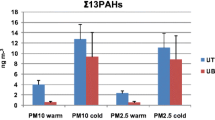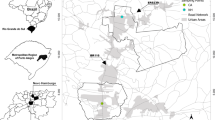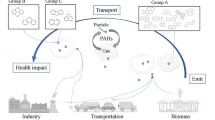Abstract
Polycyclic aromatic hydrocarbons (PAHs) are organic pollutants derived from pyrolysis and pyrosynthesis processes. Industrial activity, motor vehicle emission, and domestic combustion are the main sources of PAHs in the urban atmosphere. In this work, samples collected during the day and night in the urban area of Sarajevo are analyzed separately for gaseous and particle-bound PAHs; the possible origin of PAHs at the receptor site was suggested using different methods applied to the solid phase and to the total PAHs (gaseous + particulate phase). Finally, the risk level in Sarajevo associated to the carcinogenic character of the studied PAHs has been assessed. The result of this study suggests that (a) the total PAH concentrations were higher than those reported in other European cities; (b) the PAH daytime concentrations are higher than nocturnal concentrations: the sum of the PAH day/night ratios is 1.52 (gas) and 1.45 (particle phase); (c) stationary combustion and traffic were suggested to be the main sources of PAHs; (d) the average particle-bound benzo(a)pyrene (BaP) concentration (5.4 ng/m3) is higher than EU target annual value (1 ng/m3); and (e) PAH cancer risk exceeds the carcinogenic benchmark level recommended by the EPA mainly due to BaP during both the day and night periods.





Similar content being viewed by others
References
Arruti, A., Fernández-Olmo, I., & Irabien, A. (2012). Evaluation of the urban/rural particle bound PAH and PCB levels in the northern Spain (Cantabria region). Environmental Monitoring and Assessment, 184, 6513–6526.
Bartoš, T., Čupr, P., Klánová, J., & Holoubek, I. (2009). Which compounds contribute most to elevated airborne exposure and corresponding health risks in the Western Balkans? Environment International, 35(7), 1066–1071.
Callen, M. S., de la Cruz, M. T., Lopez, J. M., Murillo, R., Navarro, M. V., & Mastral, A. M. (2008). Some influence in the mechanism of atmospheric gas/particle partitioning of polycyclic aromatic hydrocarbon (PAH) at Zaragoza (Spain). Chemosphere, 73(8), 1357–1365.
Dimashki, M., Lim, L. H., Harrison, R. M., & Harrad, S. (2001). Temporal trends, temperature dependence and relative reactivity of atmospheric polycyclic aromatic hydrocarbons. Environmental Science and Technology, 35, 2264–2267.
Dvorská, A., Lammel, G., & Klánová, J. (2011). Use of diagnostic ratios for studying source apportionment and reactivity of ambient polycyclic aromatic hydrocarbons over Central Europe. Atmospheric Environment, 45, 420–427.
EPA (2003) Integrated risk information system. http://www.epa.gov/iris. Accessed 16 June 2010.
European Environment Agency (EEA 2010) http://www.eea.europa.eu/it. Accessed 16 June 2010.
Galarneau, E. (2008). Source specificity and atmospheric processing of airborne PAHs: implications for source apportionment. Atmospheric Environment, 42, 8139–8149.
Gambaro, A., Manodori, L., Moret, I., Capodaglio, G., & Cescon, P. (2004). Transport of gas-phase polycyclic aromatic hydrocarbons to the Venice Lagoon. Environmental Science and Technology, 38, 5357–5364.
Gambaro, A., Manodori, L., Toscano, G., Contini, D., Donateo, A., Belosi, F., Prodi, F., & Cescon, P. (2007). PAHs and trace elements in PM2.5 at the Venice Lagoon. Annali di Chimica, 97, 343–358.
Hwang, H. M., Wade, T. L., & Sericano, J. L. (2003). Concentration and source characterization of polycyclic aromatic hydrocarbons in pine needles from Korea, Mexico and United States. Atmospheric Environment, 37, 2259–2267.
IARC. (1983). Part 1, Chemical and environmental data. In: IARC Monographs on the Evaluation of Carcinogenic Risk of Chemicals to Man: Polycyclic Aromatic Compounds, vol. 32cbrs
Lewis, A. C., Kupiszewska, D., Bartle, K. D., & Pilling, M. J. (1995). City centre concentrations of polycyclic aromatic hydrocarbons using supercritical fluid extraction. Atmospheric Environment, 29, 1531–1542.
Mandalakis, M., & Stephanou, E. G. (2007). Atmospheric concentration characteristic and gas-particle portioning of PCBs in a rural area of eastern Germany. Environmental Pollution, 147, 211–221.
Manodori, L., Gambaro, A., Moret, I., Capodaglio, G., & Cescon, P. (2007). Air-sea gaseous exchange of PCBs at the Venice Lagoon (Italy). Marine Pollution Bulletin, 54(10), 1634–1644.
Martellini, T., Giannoni, M., Lepri, L., Katsoylannis, A., & Cincinelli, A. (2012). One year intensive PM2.5 bound polycyclic aromatic hydrocarbon monitoring in the area of Tuscany, Italy. Concentrations, source understanding and implications. Environmental Pollution, 164, 252–258.
Mastral, A. M., López, J. M., & Callén, M. S. (2003). Spatial and temporal PAH concentrations in Zaragoza, Spain. The Science of the Total Environment, 307, 111–124.
Odabasi, M., Vardar, N., Sofuoglu, A., Tasdemir, Y., & Holsn, T. M. (1999). Polycyclic aromatic hydrocarbons (PAHs) in Chicago air. The Science of the Total Environment, 27, 57–67.
Piazza, R., Gambaro, A., Argiriadis, E., Vecchiato, M., Zambon, S., Cescon, P., & Barbante, C. (2013). Development of a method for simultaneous analysis of PCDDs, PCDFs, PCBs, PBDEs, PCNs and PAHs in Antarctic air. Analytical Bioanalytical Chemistry, 405(2–3), 917–932.
Pietrogrande, M. C., Abbaszade, G., Schnelle-Kreiss, J., Bacco, D., Mercuriali, M., & Zimmermann, R. (2011). Seasonal variation and source estimation of organic compounds in urban aerosol of Augsburg, Germany. Environmental Pollution, 159(7), 1861–1868.
Ravindra, K., Sokhi, R., & Van Grieten, R. (2008). Atmospheric polycyclic aromatic hydrocarbons: source attribution, emission factors and regulation. Atmospheric Environment, 13, 2895–2921.
Shihua, Q., Jun, Y., Gan, Z., Jiamo, F., Guoying, S., Zhishi, W., Tong, S. M., Tang, U. W., & Yunshun, M. (2001). Distribution of polycyclic aromatic hydrocarbons in the aerosols and dustfall in Macao. Environmental Monitoring and Assessment, 72, 115–127.
Škarek, M., Čupr, P., Bartoš, T., Kohoutek, J., Klánová, J., & Holoubek, I. (2007). A combined approach to the evaluation of organic air pollution. A case study of urban air in Sarajevo and Tuzla (Bosnia and Herzegovina). The Science of the Total Environment, 384, 182–193.
Sofuoglu, A., Odabasi, M., Tasdemir, Y., Khalili, N. R., & Holsen, T. M. (2001). Temperature dependence of gas-phase polycyclic aromatic hydrocabron and organochlorine pesticide concentrations in Chicago air. Atmospheric Environment, 35, 6503–6510.
Subramanyam, V., Valsaraj, K. T., Tibodeaux, L. J., & Reible, D. D. (1994). Gas-to-particle portioning of polycyclic aromatic hydrocarbons in an urban atmosphere. Atmospheric Environment, 28, 3083–3091.
Tobiszewski, M., & Namieśnik, J. (2012). PAH diagnostic ratios for the identification of pollution emission sources. Environmental Pollution, 162, 110–119.
Tsapakis, M., & Stephanou, E. G. (2005). Polycyclic aromatic hydrocarbons in the atmosphere of the Eastern Mediterranean. Environmental Science and Technology, 39, 6584–6590.
Wania, F., Haugen, J. E., Lei, Y. D., & Mackay, D. (1998). Temperature dependence of atmospheric concentrations of semivolatile organic compounds. Environmental Science and Technology, 32, 1013–1021.
Weborn, MJ., Coleman, PJ., Passant, NR., Lymberidi, E., Sully, J., Weir, RA., (1999). Speciated PAH inventory for the UK. Department of the Environment, Transport and the Regions
Yang, H. H., Lee, W. J., Chen, S. J., & Laia, S. O. (1998). PAH emission from various industrial stacks. Journal of Hazardous Materials, 60, 159–174.
Yunker, M. B., Macdonald, R. W., Vingarzan, R., Mitchelld, R. H., Goyettee, D., & Sylvestrecet, S. (2002). PAHs in the Fraser River basin: a critical appraisal of PAH ratios as indicators of PAH source and composition. Organic Geochemistry, 33, 489–515.
Zhang, D., An, T., Qiao, M., Loganathan, B. G., Zeng, X., Sheng, G., & Fu, J. (2011). Source identification and health risk of polycyclic aromatic hydrocarbons associated with electronic dismantling in Guiyu town, South China. Journal of Hazardous Materials, 192, 1–7.
Acknowledgments
This study is a contribution to the INTERREG IIIA Project (SIMCA cod. 38) funded by the European Commission. A. Arruti would like to thank the Spanish Ministry of Education and Science for the internship period grant (BES-2007-14915, project reference CTM-2006-00317).
Author information
Authors and Affiliations
Corresponding author
Rights and permissions
About this article
Cite this article
De Pieri, S., Arruti, A., Huremovic, J. et al. PAHs in the urban air of Sarajevo: levels, sources, day/night variation, and human inhalation risk. Environ Monit Assess 186, 1409–1419 (2014). https://doi.org/10.1007/s10661-013-3463-1
Received:
Accepted:
Published:
Issue Date:
DOI: https://doi.org/10.1007/s10661-013-3463-1




